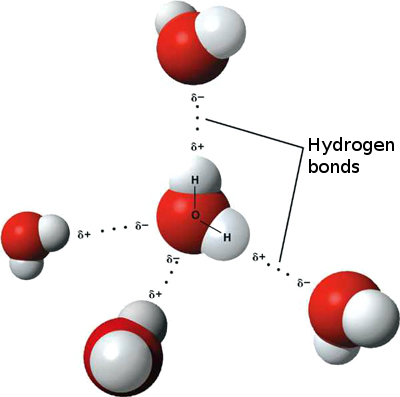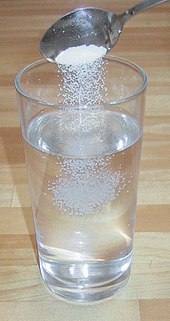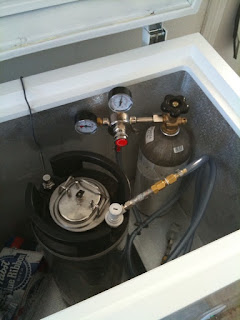
Every home brewer knows that some times a batch of beer will taste a little "off". This is not uncommon and there are ways to determine and fix these issues. I have listed some of the most common problems and how to fix them. By no means is this list comprehensive, I have tried to

cover the flavors that can be easily detected and avoided. There is a bit of a recurring theme in off flavors and that is sanitation. Above all to make amazing beer your process must be free from infection and healthy yeast must be used.
In order to fully understand where off flavors come from during the fermentation process you need to understand the chemistry behind the magic. The flow chart to the right from
Brew Chem 101 steps through the fermentation process. I would highly recommend getting this book if you are interested in the science behind making truly great beer. The process of fermentation is basically taking carbohydrates and converting them into ethanol by breaking down the sugars. Those are only the two end point though, as you can see the transformation from sugar to alcohol has many steps in between. Some of these stops along the way can actually be the very cause of the undesirable flavor. The first flavor we are going to cover is the last step before ethanol in our chemical reaction, Acetaldehyde.
Flavor: Fresh Cut Green Apples Cause:
Cause: (Acetaldehyde, CH3CHO) Green apple flavor is produced during fermentation and is common in beer that is not fully attenuated . The flavors will subside after the beer has reached full attenuation. This can sometimes be the result of using too much cane or corn sugar or bacteria. Acetaldehyde is the last step in the fermentation process before ethanol is produced.
Solution: Age the beer for a week or two and if the green apple taste goes away then kudos. If not eliminate the use of corn and cane sugar. The sugar should be substituted with malt extract. Also starting with good quality yeast will help speed the fermentation process along and reduce fermentation time
Flavor: Butterscotch, Movie Popcorn, Slickness on tongueCause: (Diacetyl, C
4H
6O
2) Like Acetaldehyde, Diacetyl is a naturally occurring part of the fermentation process, and over time will disappear if a proper attenuation is achieved. In small quantities Diacetyl is appropriate for some styles of beer. The diacetyl life cycle in your beer comes in two major steps, production and reduction. If either of these steps are interrupted inappropriate levels of diacetyl will be in your finished product.
- Production: Diacetyl is the product of Acetylaldehyde and Pyruvate to produce α-Acetolactic Acid, which gives off hydrogen ions an CO2 to create diacetyl.
- Reduction: Eventually diacetyl will change to acetonin, with an undesirable fruity, musty flavor, and then into 2,3-butanedoil which has no flavor
Solution: Properly oxygenate wort before fermentation. Make sure that you allow beer to have a "Diacetyl Rest" and wait for full attenuation before transferring (don't rack to early) . One strain of bacteria called sarcina grow rapidly during the end of fermentation and can irreversibly contaminate your beer with diacetyl. As always it is important to start off with health yeast and maintain a clean environment to avoid contamination.
Flavor: Cooked CornCause: (Dimethyl Sulfide, (CH
3)
2S) DMS is caused by breaking down of S-methyl methionine (SMM), which is an amino acid caused by malt germination. This is not really controllable by you unless you germinate your own malt. Luckily for you, malt manufacturers have it down to a science an minimize SMM in your malt and malt extract. There will be some SMM in all malt but it can be removed from your final product by following a few
Solution: The main cause of DMS that you can taste is either not cooling wort fast enough or not having a rolling open boil. Any palatable DMS will evaporate during a minimum 60 minute boil if left uncovered, and rapidly cooled. DMS is also removed by gaseous CO
2 during fermentation. If you have a weak fermentation the DMS removal will be weak so always start of with healthy active yeast.
Flavor: SkunkyCause: (MBT, 3-methyl-2-butene-1-thiol) When humulone (The bittering alpha acid in hops) is exposed to light, specifically blue-green light (400-520

nanometer wavelength), a chemical reaction occurs creating MBT. MBT is part of the mercaptan family, along with the active chemical in a skunks spray, which gives it the distinctive skunky smell.
Solution: Do not expose wort or beer to direct sunlight after hops have been added. While sunlight can be the most damaging because of its intense light source (the freaking Sun), indoor lighting can cause the same damage to your beer. Keeping fermenter inside a dark closet or covered up will reduce MBT content, and
NEVER use green or clear glass when bottling this is a recipe for skunk beer. (See:
Corona for more details)
Stale,Wet Cardboard, Rotten or Old Vegetables, Sherry, PineappleCause: (Oxidization, O
2 -> BEER) When oxygen is introduced into your hot wort it creates aldehydes and produce the stale, cardboard flavor which is unpleasant for all drinkers.
Solution: To prevent oxidization avoid hot side aeration, which is when air is mixed in the wort at temperatures above 80
°F. Only allow beer to be aerated after yeast has been pitched to aide in yeast aerobic respiration, after this has happened minimize any shaking or stiring of beer. During transfers from primary to secondary and secondary to bottles/keg is when the highest risk of accidental aeration occurs. Also only leave 1/2" to 1" of head space in bottles and use oxygen reducing bottle caps. If kegging be sure to completely purge air from head space by filling and purging 3 times. In higher alcohol beers this is generally perceived as "sherry" instead of cardboard, and(if style appropriate) not considered a flaw in many aged beer styles, such as barley wine and old ale.
Flavor: Astringent Mouth-puckering, like chewing on a grape skin, Metallic or PowderyCause: (Polyphenols known as
Tannins, Catechin is shown below) Tannins are stored in grain husks and also in the skin of fruit, and when boiled or sparged with water over 170°F they are extracted. This is because the waters temperature is directly related to the solubility of its ingredients.

Over-milling grain makes tannin extraction easier since the husks are further broken down making tannin extraction more efficient. High waters pH (above 5.2) can also increase tannin extraction. Mixing krausen into beer or transferring to secondary will increase tannins because of its concentration of the phenols.
Solution: Don’t boil, over crush or over-sparge grain, be sure to keep water below 170°F. Check your pH and make sure it is below 5.2 and avoid letting krausen get into beer.
Alcoholic/Hot spicy/SolventlikeCause: (Fusel Alcohols, Ethanol with more than two C atom) Proponol (CH
3CH
2CH
2OH) and Butanol (CH
3CH
2CH
2CH
2OH) and other fusel alcohols give beer an undesirable alcohol flavor in high quantities. However, in some beers this is an appropriate flavor, such as barley wines and some bocks. These undesirable/solvent like tastes can come from several sources like excessive yeast growth, high levels of ethanol not allowing proper fermentation, excessive amino acids, and high fermentation temperatures. In other words, when fermentation is is too fast or too strong it can overwhelm the ethanol flavoring. Also, if the yeast start to ferment amino acids instead of sugars the resulting alcohols won't be to your liking. Bacterial infections also can cause solvent-like tastes.
Solution:If style appropriate, drink it! If not, try chooseing a different yeast strain, some stronger yeast strains, meant for higher alcohol beers, can overwhelm a flavors and . AAlso maintain a sterile brewing environment and control fermentation temperatures. At temperatures above 80
°F yeast produce a much higher concentration of the heavier, long chain
fusel alcohols which are the abrasive to the palette.
Fruity (strawberry, pear, banana, apple, grape, citrus)Cause: (Esters, Acid(*-C=O-OH) +Alcohol(*-CH
2-OH)->Ester) Esters occur naturally when alcohols and acids are combined in the wort. These esters give a fruit-like flavor and aroma that are desired in certain beer styles such a lambics and sours.
 Solution:
Solution: In ales ester production is lowest at temperatures between 60°F and 65°F and high at temperatures above 75°F. For lagers the window is much lower with low ester production below 50°F and high esters above 55°F. Try a cleaner yeast strain. Oxygenate wort sufficiently to ensure yeast health. Reduce original gravity. Check hop variety for fruity characteristics and avoid carrying over excessive hot break into fermenter. Be sure to pitch a sufficient quantity of healthy yeast to avoid yeast stress.
Medicinal, Plastic, Band-aid
Cause: (Chlorphenol, Cl-C
6-OH) The most likely cause of this taste is infection caused by poor sanitation. Can also be caused by using chlorinated water or not properly rinsing cleaning solution from brewing equipment. Sometimes whole hop usage can contribute to this off flavor if a high alpha acid hop is used.
Solution: Clean and sanitize all equipment for brewing. If you really think sanitation is not the issue check your water for chlorine also be sure to rinse off all equipment and make sure no bleach (should you unadvisedly be using it) is rinsed off. If your water has high chlorine levels in it boil the water for 15 minutes to drive out any chlorine.
Yeasty Bready, sulfury, yeast-likeCause: (YEAST) C'mon really what do you think makes your beer taste yeasty? Large quantities of dead yeast are canabalized by their still living comrades. Yeast on yeast action releases bitter lipids, resins, nitrogen and sulphur containing molecules.
Solution: If beer is young let yeast properly flocculate and settle. Watch your transfer method and make sure not too much trub makes it into your new container. And ALWAYS use healthy yeast.
Sources:




















